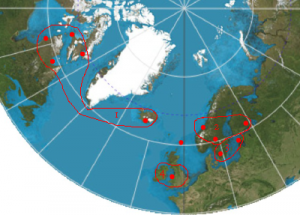For my concert last month in the Wighton Centre, Dundee, I tried to find tunes from as many different countries as I could. I was particularly keen to get an Inuit tune, because of the bowed zither traditions from Baffin Island and Northern Labrador.
I read up as much as I could about the various different traditions, and I have updated my Jouhikko web pages to include information on these different traditions. I also made a map to try and show how the different regional traditions of “bowed-harp” playing relate to each other:
The different numbered groups are my attempt to divide the different traditions. Group 1 is the bowed zithers of Canada and Iceland. Group 2 is the narrow-handhole bowed lyres from Northern Scandinavia. Group 3 is the wide-handhole bowed lyres from Southern Scandinavia, and group 4 is the fingerboard bowed lyres from Britain (though there are Continental examples of this type as well)
In the middle I have put Shetland, because no-one really knows what the form of the Shetland gue was. I like to think of it as being part of group 2, but some scholars have argued quite strongly that it should be in group 1.
I managed to get hold of the article by E. Y. Arima and M. Einarsson, Whence and Where the Eskimo Fiddle? published in the journal “Folk”, vol 18 1976. This has some very useful information about the Inuit bowed zithers including photos of a number of museum examples and alsoa photo of a soapstone carving of one being played. However it is not really clear to me exactly how these instruments were played and fingered.
The article also refers to an archive recording from the 1950s, after the tradition had died out and come to an end, when an Inuit person from Northern Labrador made a couple of instruments and played them. I am currently in negotiations to try and get hold of a copy of this recording to listen to it.

